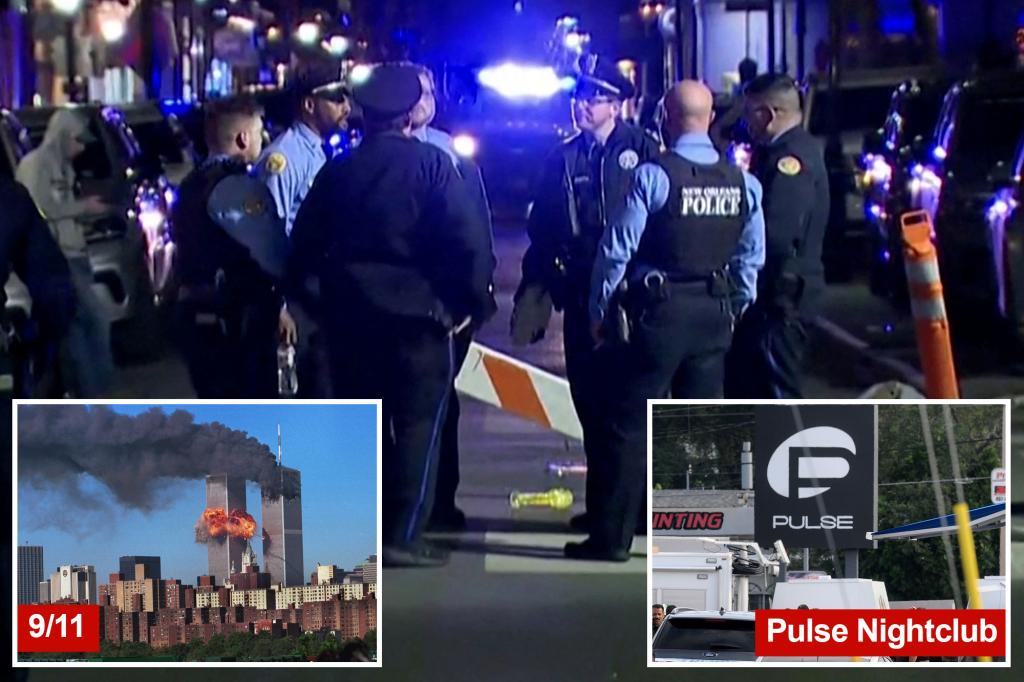The devastating terror attack that struck New Orleans’ iconic Bourbon Street has etched its name among the deadliest acts of terrorism on American soil since the harrowing events of 9/11. The initial death toll of 10 tragically climbed to 15, solidifying its grim position in the annals of national tragedy. The perpetrator, identified as Shamsud Din Jabbar, used a rented F150 truck, adorned with an ISIS flag, as his weapon of destruction, plowing through unsuspecting crowds reveling in the city’s vibrant atmosphere. The attack joins a somber list of post-9/11 atrocities, including the Orlando Pulse nightclub massacre in 2016, which claimed 49 lives, and, of course, the catastrophic attacks of September 11, 2001, orchestrated by Al-Qaeda, resulting in the loss of over 3,000 American lives.
While Jabbar’s act of driving the truck into the crowd formed the initial, brutal assault, the unfolding investigation revealed a more complex and chilling plot. The discovery of several pipe bombs, cleverly disguised as ordinary coolers, strategically placed along Bourbon Street, significantly escalated the potential for devastation. These devices, wired to a remote detonator found within Jabbar’s truck, pointed towards a premeditated plan to inflict even greater carnage. The presence of these undetonated bombs raised the chilling specter of a much higher death toll had they been successfully triggered. The FBI’s assessment that Jabbar was likely “not solely responsible” further deepens the intrigue surrounding the attack, suggesting a network of collaborators or a larger organization at play.
The New Orleans attack shares unsettling similarities with other acts of terrorism on U.S. soil involving coordinated efforts. The Boston Marathon bombing in 2013, perpetrated by brothers Tamerlan and Dzhokhar Tsarnaev, which killed three spectators, and the 2015 San Bernardino massacre, where Syed Rizwan Farook and Tashfeen Malik, a husband and wife, murdered 14 people at a Christmas party, stand as stark reminders of the potential for coordinated attacks. These incidents underscore the danger posed by individuals working in concert to plan and execute acts of terror, amplifying the potential for widespread destruction and loss of life.
In contrast to coordinated attacks, lone wolf terrorism, characterized by individuals acting independently without direct ties to organized groups, remains a more prevalent form of terrorism in the United States. These individuals are often self-radicalized through online platforms, consuming extremist propaganda and developing their own distorted ideologies that propel them to violence. Omar Mateen, the perpetrator of the Orlando Pulse nightclub shooting, exemplifies this phenomenon. His horrific act, fueled by his self-proclaimed allegiance to ISIS, tragically underscores the devastating potential of individuals driven by extremist beliefs, acting alone to carry out acts of terror.
Nidal Malik Hasan’s 2009 mass shooting at Fort Hood, Texas, where he killed 13 people, serves as another grim illustration of lone wolf terrorism. Hasan, a U.S. Army Major and psychiatrist, carried out his attack motivated by a complex mix of personal and ideological factors, including his opposition to the wars in Iraq and Afghanistan. His case highlights the challenge of identifying and preventing acts of terrorism by individuals who may not fit traditional profiles of extremism, operating within seemingly ordinary contexts. The Fort Hood shooting, like the Orlando massacre, demonstrates the far-reaching impact of lone wolf attacks, shaking communities and raising concerns about internal threats.
The New Orleans attack, with its rising death toll and the unveiling of a more intricate plot involving explosives, reinforces the ever-present threat of terrorism within the United States. Whether orchestrated by organized groups or carried out by lone individuals, these acts of violence underscore the need for vigilance and continued efforts to combat extremism. The investigation into the New Orleans attack will be crucial in unraveling the full extent of the plot, identifying any potential collaborators, and understanding the motivations behind this horrific act. The pursuit of justice for the victims and the prevention of future tragedies demand a comprehensive approach that addresses both the coordinated and lone wolf dimensions of the terrorist threat.

